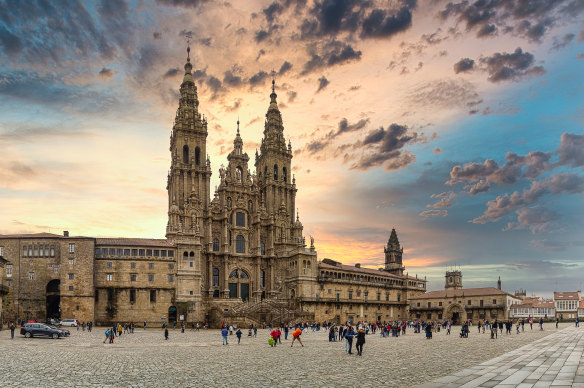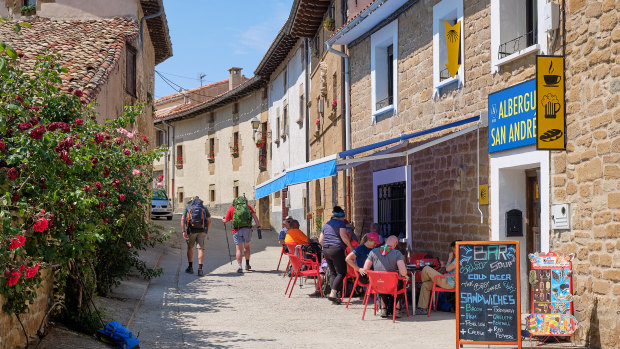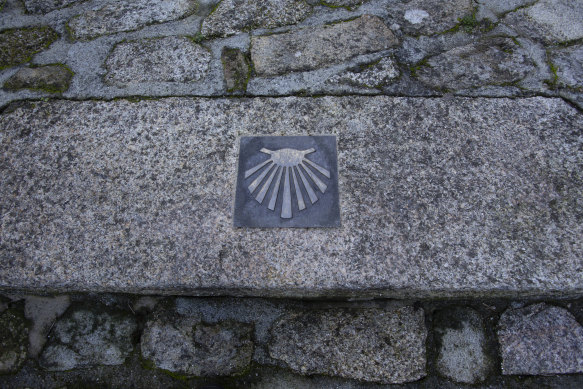Endorsed by Hollywood, this ancient way to walk Europe is all the rage
I’m late to the Camino party. About 1200 years late by all accounts. Since the ninth century, Christians have been making the pilgrimage to the cathedral in Santiago de Compostela in north-western Spain to pay their respects at what is said to be the final resting place of Saint James, one of Jesus Christ’s 12 apostles.

The ultimate destination – the Cathedral in Santiago de Compostela.Credit: iStock
That his remains are actually in the cathedral is up for debate. The legend goes that after being killed by King Herod in Judea about AD44, his body was taken by boat to Galicia, a region where it’s thought he had once preached the gospel.
After being rediscovered by a hermit in a nearby forest 800 years later, his bones were interred in a shrine in Santiago de Compostela and people from all over Europe started making the often perilous journey to pay their respects, bringing fame and prosperity to the region in the process.
Fast-forward 1200 years and pilgrimages, as you may be aware, have once again become all the rage. Countless books, TV series and movies, such as The Way with Emilio Estevez and Martin Sheen, have helped popularise the practice, exposing it to people of all backgrounds and religious persuasions.
The pandemic has only fuelled the flames – how better to clear your head after a prolonged period of punitive travel restrictions than with a long walk in a foreign land?
As someone who has never been religious, my overriding question has always been the same: what differentiates a pilgrimage from any other multi-day hike through rural Europe? Is there a different feeling? A different energy? And would the journey have the same significance for a non-believer?
I decided to find out. But not by doing the French Way, the most popular of the five UNESCO World Heritage-listed pilgrimage routes to Santiago (known collectively as the Camino de Santiago).
Instead, I would tackle the coastal variation of the second-most popular route, the Portuguese Way, which traditionally starts in Lisbon, but for my trip would begin in Porto.
To be eligible for the Compostela, the official certificate of completion issued in Santiago, pilgrims must have walked at least the last 100 kilometres of the route, collected sufficient stamps along the way in their pilgrim passport and made the journey in the name of piety. Hopefully, there’s some leeway on this last point.

A fuel stop along the way.Credit: iStock
Of course, proper pilgrims carry all their own gear and bunk down in ear plug-testing communal dorms called refugios, some of which are within monasteries. But there would be no such penance for this pretend pilgrim – instead, I opt to join a 10-day trip with Intrepid Travel.
It promises a knowledgeable guide, comfortable hotel accommodation and the assurance that my luggage will be effortlessly whisked to the next destination. All I will carry is my backpack and – if I’m being completely honest – some scepticism.
Pushing off from Porto | A coastal affair
“If I can do it, you can do it!” These are the encouraging words from our ebullient tour leader, Mariela Cavallo, during the welcome meeting on day one in Porto.
This is her fifth Portuguese Camino in a row, and she’s never had anyone not make it to Santiago. “I love this trip,” she says, “and the people from Galicia are just the friendliest.”
Tomorrow we will catch taxis over the border to start the walk in the small Spanish coastal town of Oia (despite the trip’s name, all our hiking will take place in Spain, in order to keep the trip to 10 days).
From there the route winds along the coast, through a mixture of picturesque medieval towns, such as Baiona and Redondela, as well as more established port cities like Vigo and Pontevedra, before heading inland through the spa town of Caldas de Reis to Santiago.
We’ll average about 23 kilometres per day, using a mixture of dedicated trails, meandering backroads and the occasional highway to thread our way through a scenic montage of sturdy granite villages, whispering oak forests and countless corn fields and vineyards.
Our group isn’t typical, according to Cavallo. On all her previous trips, she’s mostly had women in their 60s, whereas we have three men (a rarity) and people in every decade from their 20s through to their 70s.
It’s also an international affair, with a mix of Canadians, Brits, Americans, Aussies, Kiwis and Filipinos. Several are seasoned Camino pilgrims, having already ticked off the more popular French Way.
Over the next 10 days we bond in a way that I haven’t experienced before on a multi-day hike.
There’s lots of banter and teasing, of course, but plenty of heartfelt exchanges and soul baring too. Not only do people talk candidly about their relationships, loves and losses, but there are also deep philosophical discussions about meditation, religion and politics.
In fact, almost every conversation seems to be infused with just a bit more gravity and meaning.
Hitting the trail | In the spirit of the “good way”
If you had to sum up the trip in one phrase, it would be “buen Camino!” We hear it constantly, from fellow pilgrims, from locals on the street, through the open windows of passing cars and from the hotel, restaurant and cafe staff that stamp our passports along the route. It’s a simple but surprisingly touching gesture – a sincere wish that we have a “good Way”.
There are other defining features too – frequent stone waymarkers indicating the distance left to Santiago as well as numerous impromptu shrines, some a simple pile of hand-painted stones (traditionally representing a burden or sin that someone wishes to leave behind), others a wooden board or fence festooned with ribbons, scallop shells and poignant messages to loved ones.

A Camino waymaker.Credit: iStock
And then, of course, there are the more formal pilgrimage reminders – the countless stone crosses depicting Jesus or Saint James, the wells for feet washing and the fountains for drinking water.
Many people buy a scallop shell (the most universally recognised Camino pilgrimage symbol) at the start of their journey and tie it to their backpacks; others carry a red and white flag bearing the cross of Saint James.
They’re small gestures but they help to foster a sense of community and belonging; the feeling that we’re all in this together, all treading the same path.
As a result, it’s an unexpectedly social experience, with conversations easily struck up on the trail or at rest stops along the way.
I meet people of all ages and nationalities – four middle-aged Irish guys on rented mountain bikes, a couple from Germany pushing their child in a buggy; a group of perky Spanish youngsters who enthusiastically belt out romantic ballads as they effortlessly skip along.
And then there’s the eclectic cast of characters we encounter on the trail. Ever since people started making the pilgrimage in the Middle Ages, an entire industry has sprung up to service it.
There’s Berto, the “smoothie guy”, an unfairly handsome individual who makes delicious fresh fruit smoothies from a van in the middle of a forest; Benancio, who creates handmade wooden staffs with elaborate carved animal heads; Manolito, who sells delicate shell-shaped earrings (Cavallo wears a different pair each day) and Juan de Camino, a nomad who lives in the forest and will stamp your pilgrim passport for a modest donation.
Although the distances we cover each day are similar, a couple of the legs are particularly testing, with steep climbs, little shade and afternoon June temperatures that soar over 30 degrees.
While it’s a trip you’d want to train for (Intrepid rates it as moderate), it doesn’t require Olympian levels of fitness.
Several of our group’s older members have arthritis and need to use walking poles, but they soldier on, swept along by the camaraderie, the frequent “buen Caminos” and the promise of a coffee and a restorative pastry at the next stop.
Walking up an appetite | Savouring the local delicacies
One of the great rewards of a long-distance hike is the deluded permission it gives you to gorge yourself on record-breaking amounts of food and drink. And fortunately Galicia is a region full of delicious and intriguing specialities.
Predictably, seafood is a big focus, from the plumpest, tastiest oysters I’ve ever tried in the coastal town of Arcade (Spain’s oyster capital) to “pulpo a feira”, meaty segments of boiled octopus sprinkled with paprika. I give the region’s trademark tripe stew a miss (others assure me it’s delicious) but devour more than my fair share of seafood paella, tuna-filled Galician pies (similar to empanadas) and scorched, salt-smothered padron green peppers.
Many restaurants offer a three-course Pilgrim Menu for the bargain price of €12 ($20) and every bar provides a generous serving of complimentary tapas with each round of drinks – anything from a slice of Spanish omelette to a sizzling dish of spicy chorizos.
The only specialty I find underwhelming is the region’s lauded Santiago cake – a dense tart made from ground almonds that tastes a bit like… well, a dense tart made from ground almonds.
On the wine front, Galicia might not be as famous as Rioja, but thanks to its maritime climate, it’s one of Spain’s top regions for whites, including some dangerously drinkable albarinos, godellos and treixadura that can cost as little as €1.5 a glass.
It’s not so well-known for reds, but can still turn out a fruity mencia that pairs well with a sliced rib eye or a marbled “secreto” cut of Iberico pork.
During our stay at Hotel Antolin, a beachside property on the outskirts of Redondela, Cavallo arranges for us to sample another Galician speciality – “queimada”, a blend of 50 per cent proof orujo brandy, sugar, lemon peel and coffee beans that’s set alight and stirred in a bowl while an ancient pagan spell is recited.
Designed to ward off bad spirits (not to mention nostril hair), the potent, syrupy concoction is often prepared at festivals and family celebrations. Whether it successfully protects me from evil omens remains to be seen, but it certainly doesn’t spare me from a memorable hangover.
In step with the Almighty | A spiritual quest
As the trip progresses, it becomes clear that for three members of our group, this is a journey with genuine religious significance.
They call into each of the many churches we pass along the way and find a mass to attend when we arrive in Vigo on Sunday. One explains that for her the trip is “about reconnecting with the history of the faith”.
On day seven, while hiking from Pontevedra to Caldas de Reis, Cavallo organises for us to call into Casa de la Misericordia (House of Mercy) for an optional blessing by a Catholic hermit called Father Carlos.
When we’re shown a “Pilgrim Miracle Menu” and encouraged to choose from an “Encouraging Word” or a “Healing Touch”, I can feel my anxiety levels rise. But I stay with it, as does most of the group, and everyone agrees that what follows is one of the most affecting parts of the trip.
One by one, we each receive a heartfelt message of kindness, compassion and encouragement that would be touching however it was packaged.
For some people, it’s clearly the emotional release they needed. “I cried like a baby,” admits one man, who we later learn has a severely disabled son back home. “I feel like a big weight has been lifted from me.”
The final push | A moving finale
Our last day starts well. We spend the morning on quiet country lanes, weaving through dew-soaked vineyards to an intermittent chorus of cockerels and church bells. But then the temperature and the altitude starts to climb, and the afternoon is a challenging uphill slog in 32 degrees.
The bland, high rise-filled outskirts of Santiago provide little respite but the ever-decreasing waymarkers and our first glimpse of the famous cathedral’s twin spires in the distance help to lift morale.
During the final few hundred metres, we follow a procession of fellow pilgrims through the narrow alleyways of the city’s old town before emerging into the carnival-like atmosphere of Obradoiro Square and the impressive sight of the cathedral’s imposing stone facade.
We join the celebratory throng, hugging, cheering and taking photos, while all around us, the square echoes with triumphant cries and tears of joy.
Surveying the scene, it reminds me of something a fellow agnostic said during the blessing two days before. With her eyes filled with tears, she turned to me and whispered, “this is unexpectedly moving.”
THE DETAILS
Fly
Numerous airlines fly to Porto from Australia including Qantas, Emirates, British Airways and Qatar, often using European code shares for connections.
Tour
Intrepid Travel’s 10-day Portuguese Camino trip from Porto to Santiago de Compostela runs from September to June and includes accommodation, some meals and several hosted activities. The trip is rated as “moderate” meaning it’s suitable for active travellers with a good level of fitness. Maximum group size is 12. From $3185 a person, twin share. See intrepidtravel.com
Walk
Essential items include comfortable hiking boots, a daypack, a reusable water bottle, rain gear, a hat and lightweight, quick-drying synthetic layers. Walking poles can be useful for uphill and downhill sections. Make sure you’ve worn in your hiking boots before the trip and can comfortably hike 23 kilometres in one day on a mixture of terrain carrying a daypack with sufficient water and snacks.
The writer was a guest of Intrepid Travel.
Five more Caminos to Santiago
The original way
Allegedly the route taken in the ninth century by the first reported pilgrim, King Alfonso II of Asturias, this 320-kilometre journey begins in the medieval Spanish town of Oviedo and passes through UNESCO World Heritage-listed Lugo, a striking city surrounded by Roman walls.
The French way
By far the best-known and most popular Camino, this route begins in the pretty French town of Saint-Jean-Pied-de-Port in the foothills of the Pyrenees. Don’t fancy hiking 700-plus kilometres? Start in Sarria and tackle the last 115 kilometres instead.
The English way
Traditionally used by pilgrims from Northern Europe, this short but challenging 115-kilometre journey starts in the port of Ferrol on Spain’s north coast and winds its way south through Galicia to Santiago.
The northern way
This testing 825-kilometre route along Spain’s northern coastline starts from Irun in the Basque Country and follows the path of an old Roman road before joining the French Way at Arzua.
The spiritual variant
Essentially a detour from the main Portuguese Camino, this variation recreates part of the boat trip that brought Saint James’ remains from Jerusalem back to Galicia. The scenic 1.5-hour journey on the Ulla River passes 17 stone crosses.
Five more pilgrimage routes around the world
The Kumano Kodo, Japan
The only other UNESCO World Heritage-listed pilgrimage, the Kumano Kodo is actually a network of trails across Japan’s verdant Kii Peninsula connecting three sacred Shinto shrines. See tb-kumano.jp/en
The Via Francigena, Italy
A popular pilgrimage route since the 10th century, this challenging 2000-kilometre journey starts in the English city of Canterbury and winds its way through France to Rome. Too much? Begin in Viterbo and enjoy the last 80 kilometres through the scenic Lazio countryside. See viefrancigene.org/en
The Pilgrim’s Way, England
One of England’s oldest pilgrimage routes, this 246-kilometre journey from the Hampshire city of Winchester follows an ancient trail to the shrine of Thomas Becket in Kent’s spectacular Canterbury Cathedral. See pilgrimswaycanterbury.org
The Abraham Path, Middle East
Still a work in progress, this ambitious project aims to build a network of trails that recreates Abraham’s travels in Turkey, Syria, Jordan, Palestine and Israel. See abrahampath.org
Mount Kailash, Tibet
Considered a sacred pilgrimage by Hindus, Jains and Buddhists, the 52-kilometre clockwise circumambulation of this 6638-metre-high Tibetan peak is supposed to bring good fortune.
Sign up for the Traveller Deals newsletter
Get exclusive travel deals delivered straight to your inbox. Sign up now.